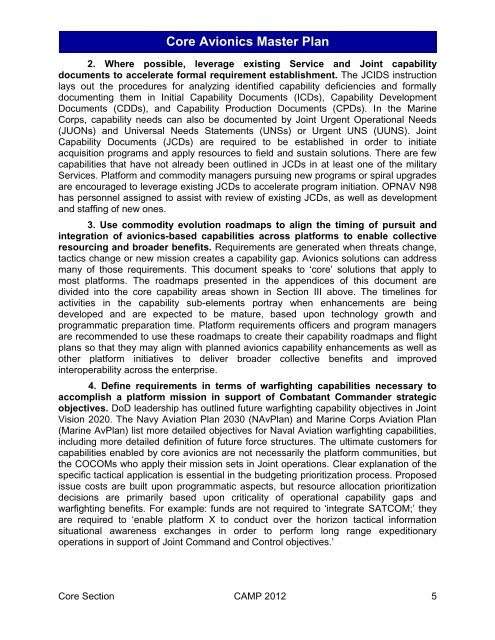PMA209 2012 Core Avionics Master Plan - NAVAIR - U.S. Navy
PMA209 2012 Core Avionics Master Plan - NAVAIR - U.S. Navy
PMA209 2012 Core Avionics Master Plan - NAVAIR - U.S. Navy
You also want an ePaper? Increase the reach of your titles
YUMPU automatically turns print PDFs into web optimized ePapers that Google loves.
<strong>Core</strong> <strong>Avionics</strong> <strong>Master</strong> <strong>Plan</strong>2. Where possible, leverage existing Service and Joint capabilitydocuments to accelerate formal requirement establishment. The JCIDS instructionlays out the procedures for analyzing identified capability deficiencies and formallydocumenting them in Initial Capability Documents (ICDs), Capability DevelopmentDocuments (CDDs), and Capability Production Documents (CPDs). In the MarineCorps, capability needs can also be documented by Joint Urgent Operational Needs(JUONs) and Universal Needs Statements (UNSs) or Urgent UNS (UUNS). JointCapability Documents (JCDs) are required to be established in order to initiateacquisition programs and apply resources to field and sustain solutions. There are fewcapabilities that have not already been outlined in JCDs in at least one of the militaryServices. Platform and commodity managers pursuing new programs or spiral upgradesare encouraged to leverage existing JCDs to accelerate program initiation. OPNAV N98has personnel assigned to assist with review of existing JCDs, as well as developmentand staffing of new ones.3. Use commodity evolution roadmaps to align the timing of pursuit andintegration of avionics-based capabilities across platforms to enable collectiveresourcing and broader benefits. Requirements are generated when threats change,tactics change or new mission creates a capability gap. <strong>Avionics</strong> solutions can addressmany of those requirements. This document speaks to ‘core’ solutions that apply tomost platforms. The roadmaps presented in the appendices of this document aredivided into the core capability areas shown in Section III above. The timelines foractivities in the capability sub-elements portray when enhancements are beingdeveloped and are expected to be mature, based upon technology growth andprogrammatic preparation time. Platform requirements officers and program managersare recommended to use these roadmaps to create their capability roadmaps and flightplans so that they may align with planned avionics capability enhancements as well asother platform initiatives to deliver broader collective benefits and improvedinteroperability across the enterprise.4. Define requirements in terms of warfighting capabilities necessary toaccomplish a platform mission in support of Combatant Commander strategicobjectives. DoD leadership has outlined future warfighting capability objectives in JointVision 2020. The <strong>Navy</strong> Aviation <strong>Plan</strong> 2030 (NAv<strong>Plan</strong>) and Marine Corps Aviation <strong>Plan</strong>(Marine Av<strong>Plan</strong>) list more detailed objectives for Naval Aviation warfighting capabilities,including more detailed definition of future force structures. The ultimate customers forcapabilities enabled by core avionics are not necessarily the platform communities, butthe COCOMs who apply their mission sets in Joint operations. Clear explanation of thespecific tactical application is essential in the budgeting prioritization process. Proposedissue costs are built upon programmatic aspects, but resource allocation prioritizationdecisions are primarily based upon criticality of operational capability gaps andwarfighting benefits. For example: funds are not required to ‘integrate SATCOM;’ theyare required to ‘enable platform X to conduct over the horizon tactical informationsituational awareness exchanges in order to perform long range expeditionaryoperations in support of Joint Command and Control objectives.’<strong>Core</strong> Section CAMP <strong>2012</strong> 5

















